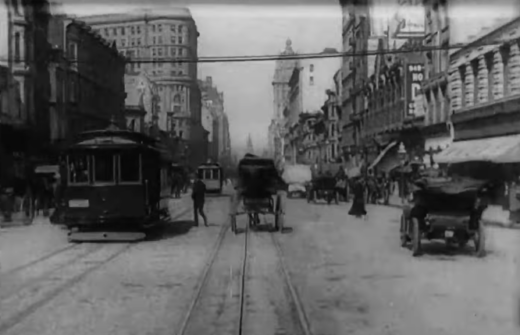The piece features a bit of philosophizing about what our streets will look like as they evolve -- and how San Francisco's past might offer clues about the coming pedestrian and traffic reality:
... Let’s consider an ancient bit of black-and-white footage, filmed in San Francisco in the spring of 1906, barely one week before the Great Earthquake and Fire. ... As the camera — which has been attached to the front of a streetcar and shakes with every jostle of the vehicle — records a journey east on Market Street, with the Ferry Building as its terminus, a different set of correlations begins to emerge.
Pedestrians cut in front of the streetcar with seeming impunity, while cars and horse-drawn carts veer in and out of traffic lanes. The effect is somewhat chaotic, as if the citizens haven’t yet learned how to use the streets. In fact, however, it is a portrait of another version of city living, in which the streets have not yet been taken over by the automobile.
“When we turned streets into pipes of cars over the past century,” Amin argues, “we did all kinds of damage to communities, we killed people, and created traffic jams.” In this glimpse of San Francisco on the eve of its destruction, then, we observe not just the city as it was but also (perhaps) as it may again be.
“The instructive thing,” Tierney said of the film during a 2016 Curbed digital symposium, “is seeing people walk without being conditioned to walk under the front of buildings. They just use the space whatever way they want. Up until about 100 years ago, that was how everyone experienced the city. Only recently have we been trained to walk dutifully along a little sidewalk, waiting for the man on the sign to turn from white to red.”
"A portrait of another version of city living"? "Trained to walk dutifully along a little sidewalk"? That makes it sound like we're missing out on some kind of pedestrian paradise of the pre-automobile past.
It made me think: How many people were dying on the city streets depicted in that 1906 film? That question prompted a quick review of vehicle-related deaths in the city, principally in city coroner's records digitized by FamilySearch.org and 1906 issues of the San Francisco Call available through the California Digital Newspaper Collection.
The overall death toll -- at least 95 in a San Francisco with less than half the population of today's city -- was surprisingly high. Also eye-opening, for me, was the principal cause of vehicle-related deaths.
The main menace plying the city streets in the year of the Great Earthquake was not automotive. Though frequent collisions involving motorcars were reported, just seven people were reported killed by motor vehicles.
Seven others died in incidents involving trains (that count does not include the dozen or more railroad workers killed in the city's train yards during the year).
Twenty deaths involved horse-drawn vehicles that struck and killed bystanders or sometimes their own drivers.
But the real scourge for people venturing through San Francisco's boulevards was the streetcar. Sixty-one people were listed as dying in incidents involving the frequently overcrowded transit vehicles. People fell from the cars. They were run down crossing tracks. Many were fatally injured as they got on or off the cars.
The Call often related these fatalities in excruciatingly explicit detail. Skulls were crushed. Heads were severed. Limbs were torn off.
Here's how the paper described the demise of a teenager named Helen Umfrid, who died while changing cars at Mission and Third streets:
"Mowed down by the thirty-ton juggernaut, her body was churned round the forward wheels and mangled so frightfully that it became almost welded to the [car] and could not be removed for more than an hour. When it was finally recovered the appearance it presented unnerved the great gathering that had watched employees of the United Railroads working round the car with primitive wrecking apparatus, and heads were turned away as it was borne to the Morgue wagon."
This account of the vehicle toll in the city doesn't count the dozens or hundreds of incidents in which people were injured. And it portrays the city at a moment when it was about to change dramatically. By 1927, automobiles ruled the streets and accounted for a huge majority of the record 158 vehicle-related deaths reported that year.
For the sake of comparing 1906 San Francisco with its modern self: The city has averaged about 30 traffic deaths a year since 2005, according to the city's Vision Zero program. The 20 fatalities recorded last year was the lowest figure in the city's modern history.
Given the city's population of roughly 450,000 people in 1906, the incidence of traffic-related deaths was about 21 per 100,000. The approximate incidence in current-day San Francisco -- where we'll use the average of 30 deaths a year and a population of 800,000 -- is 3.75/100,000.
